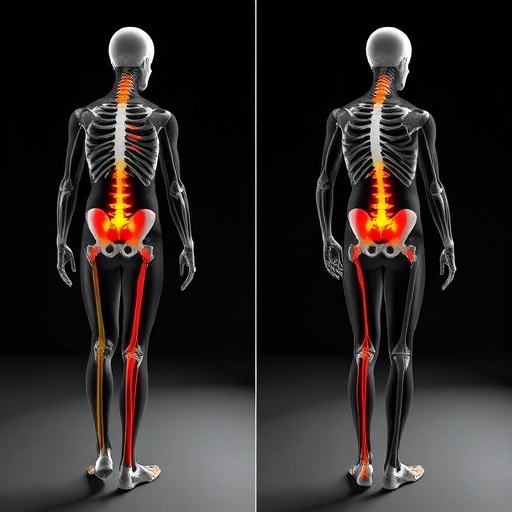
In a groundbreaking study, a team of researchers led by Liu, YF, and collaborators has unveiled captivating insights into the biomechanical variations of the lumbar spine. Their research, published in the Journal of Medical Biology Engineering, leverages advanced cadaveric computed tomography techniques to explore the intricate interplay of lumbar ligamentum flavum, disc height, and foraminal height across various postures. This study not only sheds light on anatomical variations in human cadavers but also offers critical implications for clinical practices in treating spine-related disorders.
The lumbar spine, comprising five vertebrae, plays a crucial role in supporting the upper body’s weight and enabling a range of motions. However, despite its vital functions, there remains a limited understanding of how different postures influence the anatomical structures within this region. The ligamentum flavum, a ligament spanning between the facets of adjacent vertebrae, is particularly intriguing as its elasticity is thought to impact spinal stability and motion. Through their investigations, Liu and colleagues aim to elaborate on these relationships in a structured, scientific manner.
In their methodology, the researchers utilized a cadaveric model that offers an unparalleled degree of accuracy and relevance to human anatomy. The team employed computed tomography to create three-dimensional reconstructions of the lumbar spine’s anatomy. By assessing the variation in ligamentum flavum and disc heights across different postural positions—standing, sitting, and lying—the researchers were able to capture a comprehensive snapshot of the impacts of posture on spinal structure.
One significant finding from this study is the considerable variance in disc height across the postures examined. Standing and sitting demonstrated distinct changes in disc height, suggesting that the weight-bearing status of the spine profoundly influences its configuration. One could speculate that such variations might play a role in experiences of pain or discomfort, particularly in individuals with pre-existing spinal conditions. This insight fuels further research into preventative care and therapy for those who suffer occupational strains due to prolonged sitting or standing.
Moreover, the foraminal height measurements indicated noteworthy discrepancies associated with different postures. The foraminal heights were observed to decrease when transitioning from standing to sitting, which is crucial information for understanding potential implications for neural exit pathways from the spinal canal. This aspect becomes vital in clinical settings, particularly concerning conditions like sciatica where foraminal encroachment can exacerbate discomfort and limit mobility.
An essential contribution of this work is its clinical relevance. The data gathered could inform orthopedic surgeons and physiotherapists regarding how to adapt treatment modalities based on a patient’s typical posture. The study makes a powerful case for tailoring rehabilitation protocols that account for posture-related spinal variations, which could potentially enhance healing outcomes for patients with lumbar issues. Thus, this research paves the path towards more personalized and effective spinal care strategies.
The implications of this research extend well beyond academic interest. For individuals in physically demanding jobs, understanding how posture affects spinal anatomy can lead to improved workplace ergonomics. Employers and occupational health professionals can utilize these findings to create safer working environments that reduce strain on employees’ spinal health. Similarly, athletes and sports medicine experts might utilize the insights to adjust training or rehabilitation programs according to the identified postural variations, thereby minimizing injury risk and optimizing performance.
As spine health continues to attract significant attention in a world increasingly defined by sedentary lifestyles, this timely research highlights the importance of understanding anatomical variations across postures. The findings serve as a reminder of the complexity of the human body and the need for holistic approaches when it comes to health and wellness. With rising concerns over chronic back pain and discomfort, this study is a step forward in illuminating potential causative factors tied to everyday postural habits.
The researchers emphasized the necessity of further studies to substantiate their findings and expand on underlying mechanisms that could come into play. Future investigations could explore dynamic postural variations, such as bending and twisting, to provide a well-rounded understanding of lumbar spine mechanics. This could help build a more comprehensive picture that not only traces anatomical changes but also their functional correlates in real-world settings.
In conclusion, Liu and colleagues’ investigation into the lumbar ligamentum flavum, disc height, and foraminal height variations presents an invaluable resource for the medical community. By integrating advanced imaging techniques with meticulous anatomical study, they have opened new avenues of inquiry that highlight the role of posture in spinal health. As the field continues to evolve, it is expected that their findings will inspire further research aimed at improving clinical practices for spine-related afflictions.
As we look toward the future, the pursuit of knowledge regarding human anatomy and biomechanics remains crucial. This study serves as a pivotal reminder of how even the simplest postural adjustments can have profound implications on our health, urging both clinicians and patients to prioritize spinal wellness as an integral part of overall health management. The road ahead in this field will undoubtedly be guided by these promising findings, which underscore the interconnectedness of posture, anatomy, and health outcomes.
By continuing to investigate the nuances of human movement and its effects on anatomical structures, researchers like Liu and his team are setting a benchmark for future studies. Their illuminating work not only enriches scientific literature but also bolsters the narrative for proactive health measures, encouraging everyone to be aware of their posture in pursuit of a healthier life.
Subject of Research: Variations of lumbar ligamentum flavum, disc height, and foraminal height across different postures.
Article Title: Exploring Lumbar Ligamentum Flavum, Disc Height and Foraminal Height Variations Across Different Postures: A Cadaveric Computed Tomography Investigation.
Article References:
Liu, YF., Inoue, N., Fang, YH.D. et al. Exploring Lumbar Ligamentum Flavum, Disc Height and Foraminal Height Variations Across Different Postures: A Cadaveric Computed Tomography Investigation. J. Med. Biol. Eng. (2025). https://doi.org/10.1007/s40846-025-00966-z
Image Credits: AI Generated
DOI: 10.1007/s40846-025-00966-z
Keywords: Lumbar spine, ligamentum flavum, disc height, foraminal height, postural variations, cadaveric study, computed tomography, spine health, biomechanics.
Tags: advanced imaging in spinal researchanatomical variations in human cadaverscadaveric computed tomography applicationsclinical implications for spine disordersdisc height measurement techniquesforaminal height analysisinsights into spinal health managementligamentum flavum variationslumbar spine biomechanicslumbar vertebrae structural integritypostural effects on spine anatomyspinal stability and motion dynamics





